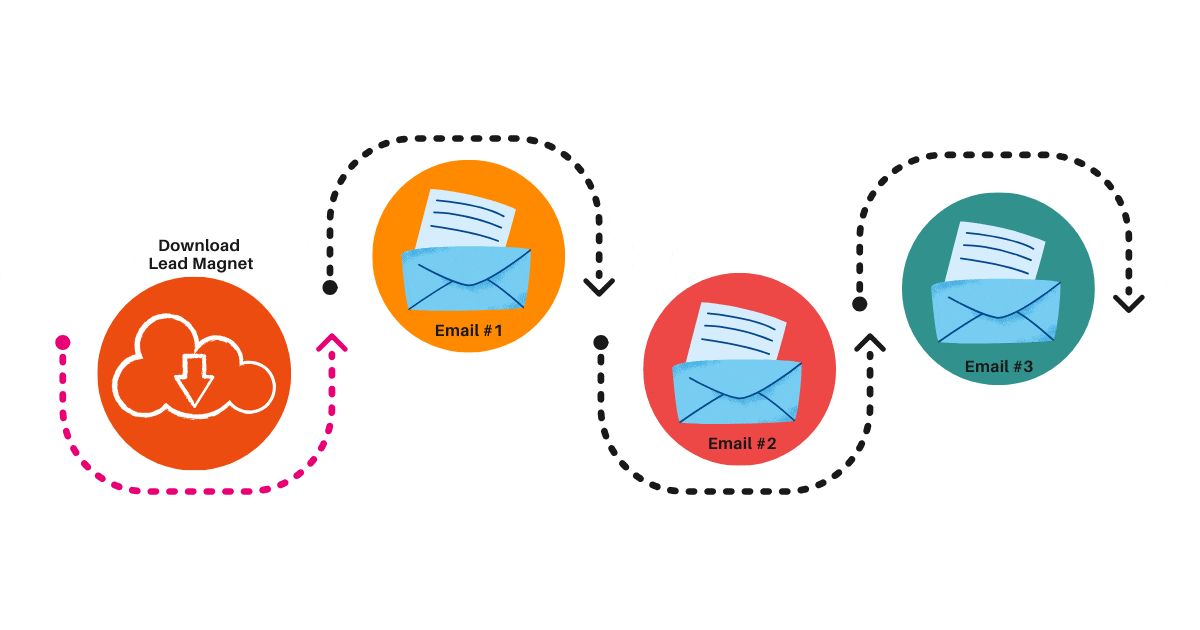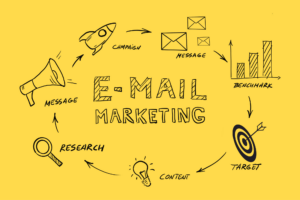
If you are a reader of our blog, you know we’ve shown you everything from how to find the perfect lead magnet topic to 10 things that all lead magnets that convert have in common to the tools you can use to build and promote your lead magnet. And while creating the perfect lead magnet for your business is essential for attracting the right prospects to your list, it’s what comes next that is vital to growing your business. The follow-up email nurture campaign you’ll send to the new prospects to turn them into lifelong customers.
Need help building a nurture #email campaign for your #lead #magnet? Here are 6 tips to help!Before we dig too deep into how to build out your lead magnet follow-up campaign, let’s stop for a minute to talk about how you are managing your contacts once they opt-in. Hopefully, the opt-in forms for your lead magnets are connected to your CRM (Customer Relationship Management) or email marketing tool.
As you collect new prospects, be sure that they are being segmented correctly in your contact database tool. This means getting them onto the correct marketing list and tagging them, so you have a record of what lead magnet(s) they signed up for. This is crucial in being able to have powerful future conversations with your prospects.
What Is an Email Nurture Campaign?
The point of the lead magnet is not to give prospects something valuable and then walk away, hoping they somehow remember you the next time they have a need for your product or service.
Nope.
The point of the lead magnet is to start a conversation with that prospect so you can build a relationship that may one day lead to a sale. And to do this, you must set up a follow-up email nurture campaign.

An email nurture campaign (or nurture email sequence) is a series of emails that are written and set up in advance, with the goals of building your relationship with a lead. The email series you create should help them understand who you are and how you can help them. If done successfully, down the line you’ll succeed in turning them into a paying customer.
The word ‘nurture’ here is critical!
Of course, the end goal is for the prospect to become a customer. But to do that you need to build a relationship with your new follower. And you need to build TRUST. That means that the aim of your nurture campaign will be to educate, not sell. You just delivered value by offering them the lead magnet. The nurture email sequence will further demonstrate that you understand their needs and have a lot more value to offer where that came from!
Tips for Creating a Successful Email Nurture Campaign
Creating a successful nurture email campaign isn’t as easy as many would think. Not every prospect is going to have the same pain points or need the same solution. That means you need to customize the experience by creating content and automation that make the experience a personal one for your prospect.
We’ve pulled together six main tips to help you get started.
[optin-monster slug=”b7idfmd29skn7id0gyel”]
Tip #1: Segment Whenever Possible
Nurture campaigns are most effective when they are personal and relevant. This means that you should not create ONE email campaign to nurture everyone who joins your contact list. Instead, segment your prospects and speak to their specific needs.
Fortunately, you already know something about that person who downloaded your lead magnet—they are interested in that specific topic! This is your starting point. Knowing this you can plan out an email sequence that expands upon that topic.
If you create a second lead magnet about a different topic/area of your business, make sure to design a second email nurture sequence to speak directly to people about that other topic.
This is why we segment our lists!

Sometimes the way a contact joins your list is more general in nature. For example, they may simply subscribe to your newsletter or blog updates. In this case, you can still nurture them in a personal and relevant way.
Some of our clients ask a ‘bucket question’ on their sign-up forms. The bucket question, based loosely on Ryan Levesque’s Ask method, involves identifying the specific categories/types of prospects you have (‘buckets’) and asking them to self-identify by choosing the bucket they identify with when they join your list.
For example, one of our clients works in the space of plant-based nutrition, and when people sign up to join the list, they are asked to classify where they are on their plant-based path – from just getting started to fully committed. Their chosen ‘bucket’ triggers the appropriate tag in the CRM, and future marketing can send different emails based on the contact’s bucket tag.
Over at Hubspot, they tried something similar in 2017 and saw amazing results in their email marketing campaign. They call their strategy ‘Pick Your Own Adventure.’ The strategy involves sending an initial email to ask what topic the prospect is MOST interested in (generating more leads, growing revenue, managing the sales pipeline, or all of the above). The prospect’s choice determines which email nurture sequence they enter.

In the end, Hubspot found that when these prospects started to receive the exact nurture emails on the topic they are interested in, email open rates soared to 67 percent, and click rates hit an astounding 61 percent!
You’ll probably start out simple with one lead magnet and one related nurture sequence, …but as you expand, always keep in mind the power of segmentation!
Tip 2: Identify Your ‘Big Ask’
Every email nurture sequence must have a ‘big ask’.
The ‘big ask’ is the one action you are driving prospects to take. Doing so either pushes them into the ‘customer’ bracket or puts them one step closer to becoming a customer. It’s crucial to identify what your ‘big ask,’ will be since it will impact other aspects of your nurture campaign.
Some possible ‘big asks’ are:
- To make a purchase
- To sign up for a subscription
- To start a free trial
- To schedule a sales call
- To watch a product demo
Once you determine your ‘big ask,’ you should evaluate it based on the following criteria:
- Friction: How easy is it for prospects to take action on your ‘big ask’?
- Proximity to Value: If the lead says ‘yes’ to your ‘big ask,’ how soon will they get value?
- Awareness Gap: How much do leads have to know about you, your company, your product/service before they will feel comfortable saying ‘yes’ to your ‘big ask’?
The answers to these questions will help you determine how much nurturing you need to do before hitting the ‘big ask’ hard in an email.
For example, ‘big asks’ that have lower friction (for example, a low-price product, a free trial without credit card info, watching a demo video) will need less nurturing than those with higher friction (for example, a high-price product or a sales call).
Also, if the ‘big ask’ gets the prospect closer to value sooner, it may be easier to say yes to, and thus require less nurturing. For example, starting a free trial means they can get value TODAY, whereas the value to the prospect is further off if they are asked to schedule a demo or call.
Finally, if you have to fill a large awareness gap before a prospect feels comfortable saying ‘yes’ to your ‘big ask,’ you will have to do more nurturing to help them understand you, your product/service, and your ability to solve their pain point. You must bridge this gap in your email nurture campaign so they can get to the level of awareness and trust needed to say ‘yes’ to the ‘big ask.’
Tip #3: Decide on Length and Frequency
Once you have chosen and evaluated your ‘big ask,’ you have the information you need to determine an appropriate length for your email nurture sequence and the duration between emails.
When it comes to length, choose a time span that will allow you to provide enough value that will help prospects feel comfortable saying ‘yes’ to the ‘big ask.’ An ask with low friction, a small awareness gap, and close proximity to value means you may only need a nurture campaign of a week or two, while you may go slower with a bigger ask (a month or more). Others may choose a longer nurture time with periodic ‘big ask’ emails intermittently spaced between value emails.
When it comes to frequency, choose the timing that feels comfortable to you, but be ready to evaluate and adjust as needed.
A prospect is hottest when they first sign up for your lead magnet. You need to find a balance to keep your emails/company noticeable and memorable without annoying the prospect. If you email too much, they may unsubscribe. If you don’t email enough, they may forget who you are and unsubscribe. Somewhere in between is a happy medium, and you must find out what that is for your business and your prospects.
Some marketers consider emailing every day to be a big no-no, but on the other hand, many large and well-known companies have success with daily emailing. To play it safe, you may want to consider sending an email once or twice per week (7-day duration between emails, or 3-4 days). Of course, you can play with any length to see what works best. You’ll measure effectiveness by open rates, opt-out rates, and if action on your ‘big ask’ is taken.
Tip #4: Gather Relevant Content
Some of the emails in your nurture email sequence are going to focus on the ‘big ask,’ but the bulk of the content should be about building the relationship and delivering value. This will require you to go through your current content and resources to find what fits best.
When gathering relevant content, make sure it is related to the topic of the lead magnet or somehow fits with how you have segmented your list/their interests. It has to be content that the lead will have an interest in.
Even if you only have one lead magnet right now, you can set yourself up for future success by identifying the topics your business talks about and doing a thorough review of all content to categorize it by topical area. This will make it easier to find relevant content for the current lead magnet. It will also help you in identifying additional topics for new lead magnets and give you a jump-start on creating nurture sequences for those other topics.
Here are some ideas for relevant content that will work in your email nurture campaign:
- Share a blog post related to the topic
- Break a longer blog post into a series of emails with tips on the topic
- Share a case study or a customer success story
- Highlight the latest industry information and updates
- Invite them to watch a video or attend a webinar
- Give them another free download related to the topic
- Answer commonly asked questions
- Share a testimonial from another customer that tells how they used our product/solution to solve their problem
- Ask the prospect to respond to a question (for example, about their pain points)
- Share stories and lessons learned from your experience
- Interview an expert
Remember that there are several goals you are looking to achieve in these emails. You are first and foremost trying to deliver value, so the prospect sees you as an expert who offers the help they need. You are also trying to build a relationship, which means sharing a little about who you are, what you do, and how your product/service can help.
You must approach this in a relationship-building way! ‘Me, me, me’ emails are not going to turn a prospect into a customer. Instead of focusing on ‘me,’ build the conversation around ‘you’ (the prospect) and ‘us’ (what your company and the prospect have in common).
Tip #5: Determine Email Flow
It’s now time to map out the flow of your emails. This will include an overview of email topics and when each will be sent to the prospect. The nurture campaign typically starts with an email that delivers the lead magnet download. It then moves to an assortment of emails that provide value and raise awareness, sprinkled with mentions or full emails that feature the ‘big ask.’
Here is a sample email flow from a fictitious sales consultation company whose ‘big ask’ is to schedule a sales consultation call:
- Email 1: Deliver lead magnet ‘9 Hot Sales Tips to Boost Your Small Business’
- Email 2: Blog post: 5 Things Your Sales Team May Be Doing Wrong (and How to Fix It!)
- Email 3: The Biggest Factor in Sales Success (email shares a customer success story and includes a soft sell of the ‘big ask’ in PS)
- Email 4: Blog post: 7 Tips from the Biggest Sales Geniuses of Our Time
- Email 5: Answers to Your Biggest Sales Questions (email answers FAQs the company gets, and includes the ‘big ask’ in the last paragraph – if you have other questions, let’s jump on a call)
- Email 6: Lead magnet: Speeding Up the Sales Process (offers a second free download related to the topic)
- Email 7: Why We Do What We Do (shows knowledge of pain points, history of the company, services offered)
- Email 8: ‘Big Ask’ (full email devoted to the ‘big ask’ – to schedule a sales consultation call)
With emails sent every 3-4 days (2 per week), this fictitious company has a month-long email nurture campaign. After it runs the course, they have several options.
For example, they may decide that they want to prolong the nurture sequence, adding more value emails sprinkled with the ‘big ask.’
Or, they may decide to move the contact over to get blog updates only, to continue the relationship and wait for them to take action on the next lead magnet/nurture series.
Or, they may decide that they’d like to further segment those who have not said ‘yes’ to the big offer. In that case, they may send an email to ask the prospect’s needs and/or pain points, and based on the answer, the prospect will move to a different, segmented nurture sequence.
For those using more sophisticated automation tools, you may choose to create spin-off nurture campaigns based on actions a prospect takes in your emails. For example, if you know a prospect clicks on a link to schedule a call with you, but then they don’t, more sophisticated automation software can apply a new tag or action to that contact that moves them into a more aggressive campaign.
Tip #6: Measure and Adjust
This final tip is a recognition that an email nurture campaign is NOT a ‘set it and forget it’ thing. Sure, it runs automatically in the background, freeing your time from manual operations, but you should periodically evaluate your campaign to assess how things are going.
You’ll want to monitor the number and percentage of prospects who are saying ‘yes’ to the ‘big ask.’ If this is your first nurture email sequence, you know what the baseline numbers are regarding the number of sales, number of discovery calls, etc. (whatever your ‘big ask’ is).
With a full nurture campaign in place, you should see those numbers go UP, and if not, it is definitely time to make some changes.

To determine where you might make those changes, look at other statistics, including:
- the open rate of each email
- the click-through rate (especially the clicks to your ‘big ask’)
- the number of unsubscribes and opt-outs
This may help you identify drop off points, unpopular emails, or when you might be making the ‘big ask’ too soon (or too late). Asking your prospects a few questions can also help you determine if you should explore better segmentation, or if there is too big a gap between the lead magnet and the product or services you offer.
Getting a prospect to have enough interest in what you have to offer that they give you their email is a HUGE first step. But signing up for a lead magnet is just the first step to transforming them into a customer. Signing up for the lead magnet indicates that the prospect is interested in that topic, but they typically aren’t ready to purchase yet.
An appropriately crafted email nurture campaign can help you build the relationship, provide further value, and get them interested in your product or service. Use these tips to get started today, and always remember to experiment to find what works best for your business and your prospects!
Don’t miss the other emails in our Lead Magnet series:
- 5 Steps to Finding the Perfect Lead Magnet Topic
- 7 Awesome Lead Magnet Ideas to Grow Your Email List
- 10 Things Lead Magnets that Convert have in Common
- 21 Inspiring Lead Magnet Examples for Small Businesses
- How to Get your Lead Magnet Length Right for Optimized Conversions
- 14 Powerful Tools to Create Lead Magnets that Converts









Thanx for providing this information. It’s totally valuable and incredible info!
Marketing with email is very important part of marketing campaign. All these tips are very helpful for us. I will implement these these tips in my next campaign. Thanks for sharing it with us.
Good insight about email marketing. i have been trying to figure out how can i get more clicks on my email